| FREE TRIAL OFFER |
Version 4, released 1 January 2011, is an extensive upgrade which took more than 2 years of intensive development and represents a major enhancement to our award winning SELLmatix Point of Sale software which retailers depend upon in 17 countries and 5 languages around the world.
We know there are a lot of POS alternatives, some good, some bad, and invite you to consider 8 factors which are critical to an informed decision about the right system for you.
In small stores you can use a single computer to run both sales and administration. With larger sites you can have up to 64 Point of Sale Terminals and Pocket PCs administered by a single machine running SELLmatix Control.
1) Will SELLmatix Work For Your Type of Establishment?
2) How Much Does it Cost?
3) Are You a Dummy?
5) What Type of Equipment do You Need?
6) How Stable and Robust is the System?
4) Is It Fast and Easy to Use?
7) Can It be Adapted to Your Needs?
8) How Long Does it Take to Get Up and Running?
Number of Terminals
The first thing to consider is the number of terminals you need. Some Point of Sale systems are single user, where sales processing and administration are handled on the same computer. Other systems are designed for multiple POS terminals with a "server" used for administration.Single user systems tend to be cheap and some have features that well suit very small businesses, but it is almost impossible to extend a single user system to run on multiple terminals effectively, unless it is designed to run multi user from the beginning.
Multi User systems are much more expensive because the design is much more difficult to implement and they are usually not cost effective for smaller sites.
SELLmatix is multi user, and was designed to be that way from the first line of code that was written. However it is easy and cost effective to implement on a small single user site, and about half our customers have single user systems.
SELLmatix has two parts. One of these is the Administration module (called SELLmatix Control), and the other part is used to process sales. That part is called SELLmatix POS. On every site you need to have one Administration Module (Control) and you can have up to 64 POS terminals processing sales.
In a large site, Control normally runs on a computer in the back office. On a small site, it runs in the background on a POS terminal. All communication between Control and the POS terminals is handled through TCP/IP networking. Even on a single user computer, POS and Control communicate through the local loopback network address.
With other POS software, the number of terminals you need to use is a big issue, and upgrading can cause a lot of problems. With SELLmatix it does not matter.
Type of Retail Business
Retail sales processing tends to be generic, and differences that do occur are usually in the back office administration and accounting. That is why generic cash registers have been used in so many different types of retail stores.SELLmatix is an effective sales processing system in a very wide range of retail operations, and can be easily interfaced with other back office systems where special requirement exist. There are two basic modes of operation, depending on the broad type of business you have.
In Regular Retail mode, SELLmatix is a retail pos system suitable for a range of applications including:-
- convenience stores
- grocery supermarkets
- liquor stores
- giftware
- drive through sales
- pharmacy
- general retail
The system can easily be integrated with head office systems which provide regular updates so that prices increases, decreases as well as product additions and deletions can be handled by a central administration center.
In Restaurant/Bar mode, customers are able to order multiple times, orders are printed in various preparation areas, and added to the customers bill. When the customer is ready to leave, the system prints their account and payment is made for the total they have consumed.
SELLmatix allows customer orders to be entered from any POS terminal or from Pocket PCs connected by WiFi network. When the order is "processed" it is sent to SELLmatix Control. Control then prints the various parts of the order where the orders are prepared. Salad orders to the Salad Bar. Cocktail orders printed in the Cocktail Bar. Main courses in the Kitchen. Coffee orders at the Coffee machines. Up to 10 different order preparation areas can be specified for each terminal. It even supports having multiple different preparation areas for the same item. This minimises wasted time by staff walking backward and forward with orders. Experienced staff who are good at upselling customers can take the orders using handheld devices. Junior staff deliver the orders and clear the tables. Result? Faster service with higher value per customer, using fewer staff with the tables turned more quickly. This makes SELLmatix software suitable for:-
- restaurant pos applications
- quick service restaurant
- Pizza Restaurants
- Fast Food Pos
- Drive Thru
- Home Delivery
The way you license the software will probably be a little different from what you expect however, once you see the different options that are available. Other high quality POS software can cost thousands of dollars which you have to pay up front before you are even certain that it will meet your needs.
Then there is the cost of upgrades, support contracts and training, so you make a major commitment and incur significant expense long before you ever realize any benefit. And if you finance the software through leasing or hire purchase, then right from the first day, you are paying interest from the first day on use of the software in later years. Not a very good deal.
Naturally, with SELLmatix, you can purchase a permanent license up from, and many customers do.
But with SELLmatix, you can pay as you go, with no long term commitment. If you change your mind at any time, just get something else. No obligation, no commitment.
And the price for a subscription is pretty good too. Less than most of our competitors charge for upgrades.
Perhaps you think we are crazy, and can't understand why we would do this. Actually, it is pretty good business for us. We are not new to this business. We know our renewal rates. We know that once you have installed the system, you will continue using it provided it works. And our software does work.
Sure, we don't make as much money up front, but our current renewal business makes us profitable, even if we didn't make any sales. Not only is that good for us, it is good for you too because it means that we are stable and able to continue maintaining and supporting the system. Many competing software companies have severe difficulties when the economy slows and that affects the cost and availability of services you need.
So the thing for you to consider is whether you want to pay a large amount of money up front, or incur a financial liability you have to pay anyhow buying other software, without actually knowing how good it really is... Or whether you want to save money when you install and pay as you go. That's why most of our customers choose an annual subscription.
Besides, with us you have no risk.
But in that case, you will need to outsource some of the technical work, configuration to someone else. Depending on where you are located there may already be a SELLmatix agent who can help you. If not, we are happy to work with local support people you recommend. Just Contact Us.
But what if you are not a dummy? If you know the business of retailing, and you have reasonable technical skills, then you can do it yourself. More and more people do every year. Certainly there is a learning curve to go through. How big that learning curve is, depends on how much you already know and how quickly you pick things up. But plenty of others have done it, and you can too.
Or, what if you are a dummy, but don't want to stay that way? Perhaps you want to learn and gradually take control of things yourself. You don't mind paying for the services you need, but you want to be able to do as much yourself as you possible can.
That's the problem with a lot of other POS systems. They assume you are a dummy, and they want you to stay that way. They want you to pay them for everything that needs to be done, and once you have bought their system, they try an lock you in by restricting information and forcing you to go back to them, and pay them, for everything.
With SELLmatix, we publish all the documentation online. Not just some parts. Everything. You don't have to pay for the manuals, or updated copies when the documentation is updated. It's all there. 24/7. The latest information available whenever you want.
With SELLmatix Version 4, we have moved the documentation to a Wiki so that experienced users and trusted dealers can add to and clarify things where appropriate. This also allows for easier translation to other languages. The software runs in many languages, and the Wiki makes translating the documentation easier to manage.
In addition, we have the support forum, where people can search for the answer to questions others have posted, and where they can receive a knowledgeable response from experienced people who know the system. Even the programmers and analysts who designed the system visit the forum every day.
Why? We are a software development business. We are in the business of designing and writing software. While we understand that support and help is needed, we want to minimise the number of staff we have to hire and train to answer the same questions time after time. So we make it easy for people to help themselves.
Our competitors have large support infrastructures and they depend on support revenue to stay in business. For them, publishing their documentation and making it easy for retailers to help themselves would hurt their business. For us, it helps.
So what is best for you? If you are a dummy, and you want to stay that way, the fact that we openly publish our documentation really makes no difference. SELLmatix dealers can provide the same turnkey solutions where you just need to pick up the phone, and they are happy to do so. But a SELLmatix dealer won't force you to remain a dummy. They will let you do as much as you want to do, and you can call them in for the things you can't do, or don't want to do.
Whatever system you choose now, you hope it will remain in service for at least 5 years or more. At some point during that period, there will probably be a time where you want to make changes to the system without calling in someone else and paying them to do it for you. Even if you do need a lot of help in the beginning.
Why eliminate that possibility now, and lock yourself in to unnecessary charges later? As you consider the alternatives, examine the online documentation carefully, even if you plan to contract out most of the work in the beginning.
This site contains everything about our system. Even though some of it is quite technical, you can learn it if you want. You have the choice.
If the other systems you are considering just have flashy graphics and buzz phrases, there is a reason. Unless full documentation available online from the beginning, you could be locking yourself into being a dummy for the next five years. Or more.
Smart retailers choose SELLmatix.
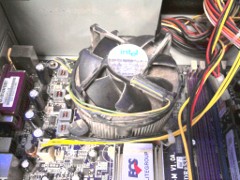 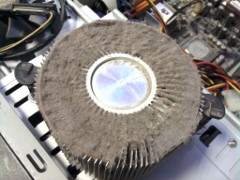 "Inside doesn't look too bad... But dust builds up at the CRITICAL place where the CPU fan over the heat sink to keep the CPU cool." |
The reason why so few competitors use the "C" programming language is just that it is too difficult for them. Languages like C++ and C# are fatware extensions of "C", which make it easier for programmers, but at the price of programs that are many times larger and need far more powerful processors and memory to achieve acceptable performance. And those machines run much hotter.
Low initial cost however, is just one side of the coin. The other is reliability and low maintenance cost. Retail systems run for extended hours, much more than a typical home or office PC, and often in a far more hostile environment. Hard disks spinning at 5000 revolutions per minute, and fans blowing cooling air over processors to keep them at safe operating temperature, hour after hour, day after day, month after month and year after year.
After 2-3 years of heavy use, bearings in the disk drives will start to wear. Jolts and bumps will cause disk drive heads to crash into the surface of the hard disk platers causing data errors. And the CPU fans which are needed to force feed cooling air over processor heat sink, have a side effect of building up dust which blocks air exactly where it is needed.
The picture on the right shows an Intel P4 after less than 3 years work in a typical retail shop. The main circuit board is a little dusty, but no big deal. The real problem can be seen however when you remove the CPU fan because the dust is completely blocking air from passing over the heat sink.
Fans blow far higher volumes of air over the hot areas, and so the dust collects on those areas far more quickly, and the result is that the dust blocks the airflow making things worse. If you are lucky and the heat sensors are working, the processor will slow down to a crawl to avoid heat damage. That will just make the system unusable. If if the heat heat sensor fails, it can permanently destroy your CPU.
With SELLmatix Version 4 however, because the programs are written in "C" and are so small and fast, you can get the same performance as other systems using slower processors which not only cost less, but have no moving parts. The Linux version can run on low power machines without a cooling fan, and using as little as 16Gb of Flash Disk, with no moving parts, instead of a hard disk spinning at 5000 RPM.
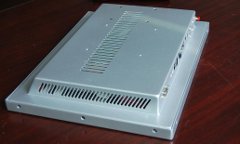 "One rugged example with everything built into the back of a 15" touch screen, with No Moving Parts. No Fan, No Hard Disk, just a 16Gb solid state flash disk." |
Lower cost. Lower maintenance. Better reliability.
Of course there are arguments in favor of other systems as well. Compact Client machines like the one shown on the left are not as readily available as other types of system. If you want to use the machine for something else as well as POS, other types of system may be better. And cheap parts for "white box" computers are available everywhere. That's a decision you have to make.
But even if you choose a different type of POS terminal, you still get better reliability with SELLmatix. The reason is that the speed of the fan adjusts to how much work the processor is performing. When the processor has to work hard, it heats up, and the fan starts turning faster. With SELLmatix POS, the processor doesn't have to work so hard, so it doesn't get so hot and the fan turns slower. So the dust builds up more slowly and the system needs less maintenance.
Naturally, with SELLmatix you can use all the standard devices such as receipt printers, barcode scanners, cash drawers and pole displays as are normally used. You are not restricted to a particular model or brand of device. Almost anything that uses a serial (RS-232), parallel or USB interface will work fine.
That means that when you put in SELLmatix, you don't have to upgrade all your equipment at the same time. If you have an old system, there is a very good chance that you can continue using your old barcode scanners, receipt printers, scales etc., and then upgrade these components when they wear out, or cash flow makes the upgrade easier.
Thrifty retailers choose SELLmatix.
With Client/Server, or web based systems, everything that happens on each POS terminal is sent to the server. A barcode is scanned, so the system sends the barcode number to the server, which looks up the item and sends the details including the description and price back to the terminal.
But what happens if a network cable is cut? What happens if a switch fails? What happens if the server goes down? The entire system goes down. You might have a busy hardware store, or supermarket with 12 check-outs and customers queued at each one, and all it takes is for one $100 switch to fail, or somebody trips over a network cable, and the entire system goes down. Every single check out.
Instead of using a client/server design, SELLmatix uses store and forward. Sales processing is faster because all databases are replicated on each machine, so there is no need to wait for a response from the server. Under normal circumstances, the totals on the server are updated just as quickly as on a client/server system.
But in the even of a network failure, or the server going down, each POS terminal can continue running as if nothing had happened. When the network connections are restored, the transactions are passed, the files updated and operation resumes automatically.
Not only that, but in the event of a catastrophic failure, say in a fire where equipment was destroyed, provided that just one machine survives, since the databases are replicated or backed up onto each terminal, the system can be rebuilt with a minimum of difficulty.
During the service life of your system, the chances are that some component will fail at some point. When that happens, do you want a robustly designed system like SELLmatix, which minimises the downtime and eases recovery? Or do you want a client/server or web based "union" system of "one out, all out", and major recovery problems? Back to top
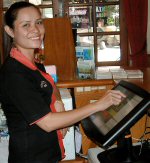 "The system gives a much quicker service to our customers, and a much more professional image." |
Every input required from an operator takes time. SELLmatix has been carefully designed to reduce the number of inputs required to an absolute minimum. Steps that require 5 or 6 inputs on other systems, on SELLmatix can be reduced to a single touch. For example, if a customer hands the cashier a $20.00 note as payment, on other systems the typical keystroke sequence would be to press the "2" button, the "0" key 3 times (usually no decimal point) and then the "Cash" button. A total of 5 inputs into the system.
On SELLmatix, most configurations have that reduced to just ONE input. To make it even easier, you can show a picture of the currency note on the button that is pressed. Everything the operator needs to do is reduced to the minimum number of steps.
Another factor is that every input is an opportunity for an error. Not only does it slow down operation, but work is added correcting the errors, often from more experienced staff.
Other computerised Point of Sale systems are designed from the perspective of a typical computer system. They have cluttered displays, with dialog boxes and "OK" buttons designed for office staff using a mouse. But retail sales clerks rarely have the computer skills of office staff, and who wants to spend the time and money training them to that level?
The first POS system we ever installed, almost 30 years ago, in a 12 month period processed an average of one transaction every 37 seconds, 24 hours per day, 7 days per week, 365 days per year, from a single terminal. That sort of transaction volume would be absolutely impossible with many of the complicated systems available today.
The same operator will process more transactions more quickly using a SELLmatix systems than virtually any other system available. That means you need less operators to process the same volume of sales. It means you need less POS terminals and less equipment to service the same volume. And it means happier customers served more quickly, who are more likely to come back to you business because the check-out is quicker and less hassle.
And one other thing. It means less staff training cost. Clerks who have used a cash register pick up use of SELLmatix almost instantly. That means that when staff don't turn up to work, you can have that checkout operating again in minutes. Not wait hours or even days to train someone new.
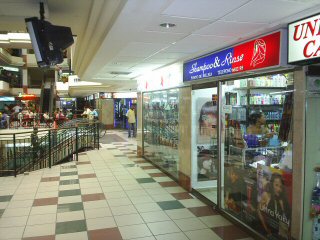 Shampoo & Rinse supplies cosmetics and ladies accessories. |
Naturally all the usual types of POS devices can be used, including scales, scanners cash drawers, printers etc. For many devices it is just a matter of selecting the device. If you have an unknown device, you can create a driver (or modify an existing one) without too much trouble.
In fact, with SELLmatix, it goes much further than that, because of the way the system was designed. SELLmatix uses a revolutionary concept of input and output "events". Hardware devices that generate input can be can be configured to generate any type of input event. And when the system needs to generate output, it sends output events. Devices that receive output from the system and be configured to respond.
This extensible approach means that even devices which did not exist when the software was designed can be configured to work with SELLmatix. For example, on hardware manufacturer of RFID devices uses SELLmatix to demonstrate their hardware in retail applications. Without any need to modify the software.
Other systems have a much more limiting design that often requires extensive code changes to handle new devices. But with SELLmatix, it is much more easy and flexible, because of the way the system was designed.
Similar flexibility exists for importing and exporting data. Most software has some way to import and export, but with SELLmatix you can configure templates or translation tables so that data can be imported from almost any format, and exported in almost any format. With other systems, special programs need to be written to handle the same thing.
Obviously no "off the shelf" system can handle every possibility. But if anything can be adapted to your needs, the chances are that SELLmatix can.
Currently the record stands at 2 hours and 4 minutes after unpacking the equipment from the boxes. That was a single terminal installation in a Hotel Bistro with a fairly limited lunch menu, but it is still very fast.
There are several reasons why SELLmatix is so fast to get up and running. First you can import product files to eliminate or minimise data entry.
If you have the same products as another store, but different pricing, you can use the other shop's product file, and then configure the system so that price overrides update the master files. Change the price once, and then the updated price is sent to every terminal and used after that. Once all the price changes have been recorded, you revert to normal pricing. This slashes days of installation and configuration in some cases.
Even where no product file exists, the system can be used to "Add Products on the Fly". On each sale, the clerk enters the details for the first item scanned and not found, and sells the other items on that sale by department, just like an old cash register.
All that needs to be entered is the description, department and price, so it only takes a few seconds and customers are not delayed. The POS terminal sends the new item to the Control Module which then sends the product to all the other terminals. 30 seconds later, if the same product is scanned on another terminal, it is found and processed normally.
Other systems require that every product be manually keyed into the system before sales can be processed. This technique eliminates the need to employ staff to key product files, and usually within just 2-3 days, 90-95% of the products are on file.
While the time taken to get up and running depends on a range of different factors, these features dramatically reduce the time and cost to implement SELLmatix. Regardless of the type of business, with SELLmatix you can implement your system faster and cheaper.